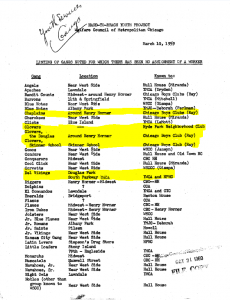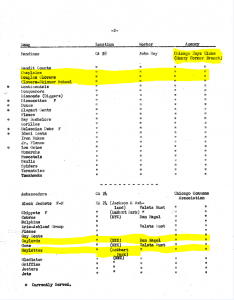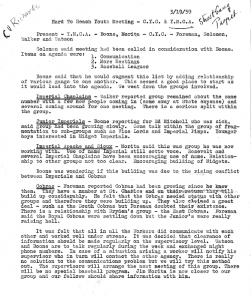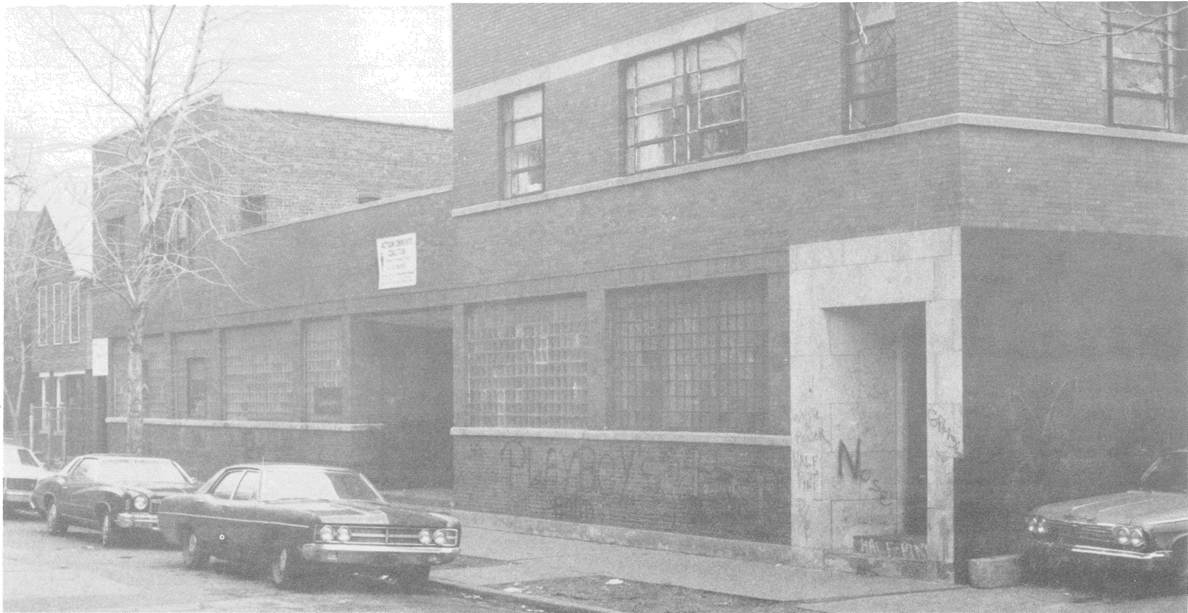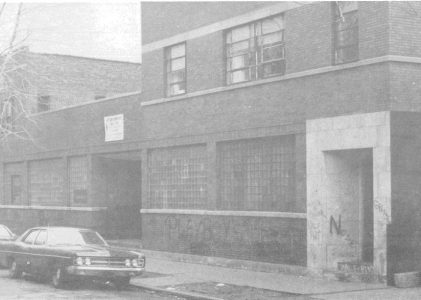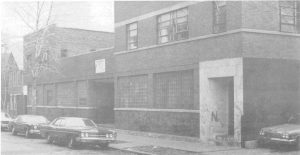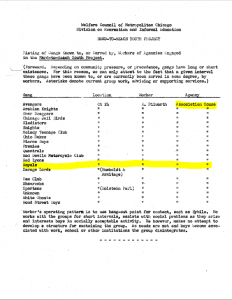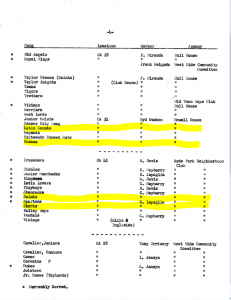Some people still ask me where I get my information, and of course I have to tell them I get it from several sources. One resource that has been a big help for me researching organizations that formed prior to 1960 is this document I obtained from the Chicago History Museum some time ago. I have posted images of this document page by page for your viewing pleasure.
In the mid-1950s, street gangs in Chicago were becoming excessively violent in comparison to the level of violent street gangs displayed in the first half of the 20th century. Of course, the level of violence in the 1950s is nothing compared to later decades but Chicago in the mid-1950s this was just scary to residents and the police. The focus on organized crime and the Italian Mafia began to shift by the later half of the decade as street gangs became to steal the spotlight from the Italian gangsters we grew to knew and love. The youths were now breaking into cars, houses, snatching purses, brawling in the streets and in some cases selling drugs and committing murder. One of the first documented drive – by shootings happened in Bridgeport on Morgan street when greaser gangster drove by who they thought was a rival gang and blasted their target with a 12 gauge, killing the target instantly in front of the Old Dutch store at 32nd and Morgan. The shooting made headline news and the public hung on breathlessly during the trials of 14 youths that allegedly carried out the shooting. Some of boys were incarcerated in juvenile detention for the murder Particularly William Torrence who was caught stealing an automobile and leading the police on a high speed chase just after he stood trial for the Bridgeport murder. This was just shocking to Chicagoans. The youth had seemed to lose their minds and were killing and committing violent crimes, a big change from the juvenile thugs that stole candy from the store and threw rocks; now this new generation was committing serious crimes. Chicago residents were now living in fear and locking their doors tight at night while others were talking to realtors and looking at catalogs all about moving to the suburbs.
In the late 1950s, the public was shaken enough after reading articles about shootings, stabbings and other wicked crimes perpetrated by gang members; those that didn’t want to move from their homes turned to the city for answers about who was that group of hooligans hanging out in the park down the street. The city answered the concerns of residents with a sweep of the worst epicenter of gang activity in North Lawndale in March of 1957 when it seemed every troubled black youth was violently swept up by angry cops. The second approach was more beneficial for gang members and for the community, social service.
The Welfare Council of Metropolitan Chicago sat down in 1956 and devised plan to branch out around the city in especially troubled neighborhoods or neighborhoods where the police reported gang-related crimes and set out on foot and get to know these troubled youths. The Welfare Council of Metropolitan Chicago broke up into teams and linked up with youth services centers around the city to steer gang members toward participating in positive youthful activities at the nearest youth centers around the city. The part of the process was visit these communities and find the gang members and document where they hung out. Once the social workers located the gangs they approached them and got to know them learning their ages, regular hangouts and if they would be interested in attending the nearest youth centers to get free enrollment in activities or maybe even some handouts, many gangs gladly obliged while others turned the offers down. The great thing about the gangs that accepted the help it gave us permanent evidence that these gangs existed long ago, backing up several stories told by generations of gang members.
Social workers did their research and provided aid throughout the late 1950s working with a project known as the Hard-to-Reach Youth Project. In March of 1959 a list was complete of all the gangs they had documented and by 1960 the list was put together for presentation outlining the social problem at hand. This was a useful tool to show the city where the most troubled areas of Chicago were and to link a correlation between poverty and higher crime and increased gang activity. These communities with the largest gang list happened to have the most needs and now this was proven by 1960 thanks to this project.
There were several Social Service sites all over Chicago, some still exist today such as: YMCA, Hyde Park Neighborhood Club, Association House, Benton House, Chicago Commons Association, Chicago Youth Commission and Near West Side Community Committee. Each gang was assigned to report to each of these community centers based upon their hang out locations and perhaps based upon the addresses of the gang members.
The most prominent houses for tending to well-known gangs around Chicago prior to 1960 were as follows.
Association House
Address: 1116 N Kedzie Ave, Chicago, IL 60651 (Haddon and Kedzie)
Neighborhood location: West Humboldt Park
Communities served approx: West Humboldt Park, East Humboldt Park, Wicker Park, Ukrainian Village, Southern West Town some Near West Side
Notorious gangs served: Taylor Street Dukes, Royals (Not Simon City Royals)
Chicago Boys Club – Henry Horner Branch (CBC-HH)
Address: Near West Side near Henry Horner Homes (Historical)
Neighborhood served: Near West Side for Henry Horner residents
Notorious gangs served: Imperial Champlains, Clovers
Chicago Commons Association – (CCA)
Address: Grand and Morgan Street intersection (Historical), Bucktown location (Historical)
Neighborhoods served approx: Bucktown, Logan Square, Noble Square, River West, East Village, some of Near West Side
Notorious gangs served: Gaylords
Chicago Youth Commission (CYC)
Address: 208 South LaSalle Street, Suite 1540, Chicago, IL 60604
Neighborhoods served approx: Anywhere
Notorious gangs served: Imperial Champlains Egyptian Cobras
Howell House
Address: 1831 S Racine Ave, Chicago, IL 60608 (18th and Racine, historic)
Neighborhoods served: Lower West Side (Pilsen
Notorious gangs served: Texans (Latin Count name pre-1959), Latin Counts
Hyde Park Neighborhood Club (HPNC)
Address: 5480 S Kenwood Ave, Chicago, IL 60615 (Garfield Boulevard and Kenwood Ave)
Neighborhoods served: Many south side communities such as: South Chicago, Hyde Park, Kenwood, Washington Park, Englewood, Archer Heights, Grand Boulevard, Douglas, Roseland, Chatham, Burnside, Greater Grand Crossing, Woodlawn, Calumet Heights, Avalon Park, Fuller Park, Gage Park? Brighton Park? New City (Back of the Yards)?
Notorious gangs served: Saints (Almighty Saints)?, Del Vikings (Kingsmen Raiders), Clovers
Hull House
Address: 800 S Halsted St, Chicago, IL 60607 (Polk and Halsted)
Neighborhoods served: Near West Side
Notorious gangs served: Ambrose
South Parkway YWCA
Address: 6600 S Cottage Grove Ave Chicago, IL 60637
Neighborhoods served: Greater Grand Crossing
Notorious gangs served: Del Vikings (Kingsmen Raiders)
West Side Community Committee – WSCC (Now known as Near West Side Community Committee)
Address: 1044 W Taylor St, Chicago, IL 60607
Neighborhoods served: Near West Side
Notorious gangs served: Spartans
South Side YMCA (location in Woodlawn)
Address: 6330 S Stony Island Ave, Chicago, IL 60637 (63rd and Stoney Island)
Neighborhoods served: Various south side neighborhoods in the area
Notorious gangs served: Del Vikings
Now let me guide you through a breakdown of each page of this sacred document that provides hard evidence about the existence of our most well known organizations in Chicago.
